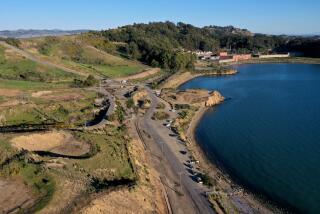SEAL BEACH : Prime Beach Land Lies Vacant: Why?
- Share via
It’s the kind of real estate that developers dream about: a flat 10 acres where the San Gabriel River flows into the Pacific Ocean. The land is centrally located in Seal Beach and offers stunning marina views and cool ocean breezes.
For nearly 20 years, Seal Beach residents have envisioned a hotel and park on the property.
But today, the land remains vacant, a testament to bad timing, a weak economy and--according to some residents--government bureaucracy.
The acreage, on Marina Drive and 1st Street just across the river from the sailboats and restaurants of the Long Beach Marina, is one of the largest pieces of undeveloped coastal property in Seal Beach.
The Los Angeles Department of Water and Power owns the land, and for years it was home to a large steam generator.
Its future has been an issue since the generator was razed in the 1960s. When a massive condominium development was proposed in the early 1970s, nearby residents banded together in an effort to preserve as much of the land as possible for open space.
“It’s such a beautiful location,” said Georgiana Brown, who has long fought for a “balanced development” on the land. “We would have hated to have solid condos developed there and have no access to anyone else in the city.”
The condominium idea never got off the ground, but the residents stayed in contact.
Eventually, they helped draw up a master plan for the site with assistance of environmental groups, the city and the DWP.
The plan allows for 30% of the land to be used for a hotel, leaving the remaining seven acres for a public park.
When it became final in the early 1980s, the plan was hailed by urban planners as an example of how acrimonious development conflicts could be avoided if n property owners and nearby residents work together to resolve differences.
“We tried really hard on this,” Brown said. “We recognized that (the property) had to have an economic base in order to have the park.”
Back in the early ‘80s, several developers expressed interest in leasing the land from the DWP and building a hotel.
The most serious discussions involved the Hilton chain. Those plans eventually fell through.
Interest in the land cooled with the coming of the recession. And with the recent openings of several new hotels in the Long Beach area, it is doubtful that still another hotel would be built in the near future, residents and officials agree.
But other residents also blamed the DWP for failing to attract a developer.
They have long complained that the agency is slow to deal with developers, who in turn are reluctant to deal with such a large bureaucracy.
“Most developers didn’t have the patience to hang around for the DWP,” said Gordon Shanks, a Seal Beach community activist who believes that the hotel would have been built by now had officials been more cooperative.
Several proposals for the property “died because of the DWP,” he said.
But because of the land’s setting, some residents are perfectly content with all the delays and failed deals.
And city officials predict the site will stay vacant until the economy improves.
More to Read
Sign up for Essential California
The most important California stories and recommendations in your inbox every morning.
You may occasionally receive promotional content from the Los Angeles Times.







